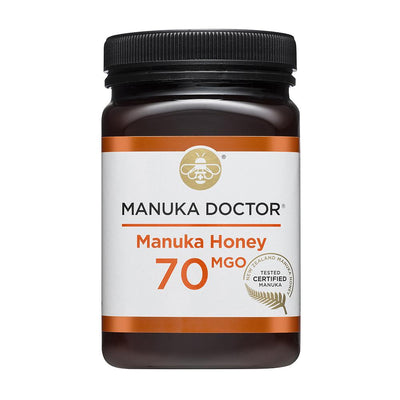We’re proud to assure customers that every pot of Manuka Doctor Honey is real Manuka Honey. Sourced from our own beehives in some of the most remote natural landscapes in the country. Then tested, certified and packed in New Zealand itself. Giving you the best product all the way from Hive to Home.
How can you tell if it’s a genuine Manuka honey?
Manuka Honey can only come from New Zealand. But data says more is sold around the world than is produced!
Sadly because it’s a premium product for health and wellbeing, Manuka honey is subject to food fraud, copies, fakes and scams.
That’s why every batch of Manuka Doctor honey is tested in independent labs. You can even see the results of the tests undertaken on your batch by typing in the batch number into our online checker. We test to the New Zealand Government’s MPI Standard to prove it is genuine, as well as testing for the MGO level to guarantee strength.
All Manuka Doctor honey is also packaged in New Zealand itself. This means you have a higher level of food security. Because when the lid is screwed onto your jar, nobody opens it until you do. Some non-New Zealand brands choose to export Manuka honey in giant metal drums which could be subject to blending, mixing and chemical changes before being re-packed locally. Manuka Doctor ALWAYS packs in New Zealand to give you full transparency over where your product is from.
What makes Manuka Doctor different to other brands?
We’ve been exporting honey from New Zealand to the UK and Europe for nearly 20 years. In that time we’ve grown to be the biggest independently owned Manuka Honey brand, selling in more than 30 countries.
There’s four reasons to choose us for your Manuka honey.
- PRICE. Owning and operating our own bee-hives and packing facility in New Zealand allows us to offer very competitive prices. We pride ourselves on offering outstanding value, offers, promotions and sales.
- QUALITY. You’ll get 100% pure, raw and un-pasteurised Manuka honey. Just as nature intended. Independently tested to New Zealand Government Export standards.
- TRUST. With thousands of verified reviews and EXCELLENT status on TrustPilot, you can be confident our products are loved by customers around the world and reliable for wellness.
- SERVICE. Our bases around the world means we’ll send your products quickly and safely. While our dedicated teams in each region can help you with questions and recommendations.
Fake Manuka honey: The main problem for shoppers
Fake honey blended with cheap sugar syrup has been exposed in an investigation by the European Commission which found 46% of sampled products were suspected to be fraudulent.
The action was led by the European Commission's directorate general for health and food safety.
Investigators tested 320 samples and found that in total 147 (46%) were suspicious, where "at least one marker of extraneous sugar sources was detected".
The EU's anti-fraud office (Olaf) said: "Such practices defraud consumers and put honest producers in jeopardy as they face unfair competition from operators who can slash prices thanks to illicit, cheap ingredients."
Click here to read the report.
Manuka Doctor’s Hive to Home promise means your honey can be traced right back to the beehive where it was created.
Why is Manuka Doctor honey sold in plastic jars when some is packed in glass?
Genuine Manuka honey can only come from New Zealand.
That’s why the vast majority of real Manuka Honey you can buy in the UK and Europe is in plastic jars – simply because it is lighter to transport by sea than glass and it doesn’t break in transit.

All Manuka Doctor honey is packed in rPet recycled plastic and is BPA free. This means we use recycled plastic to make the jar, and when you are finished, it can be recycled again to make more.
If you ever see Manuka honey in glass jars, it is highly likely to be emptied from large metal drums and then repacked outside of New Zealand. In our opinion, this is an unnecessary step in processing. It adds a further manufacturing point where your honey could be contaminated, blended, or mixed. Some people may prefer glass – but it’s very unlikely that’s how it left New Zealand.
Shoppers! Use this checklist to help ensure you buy real Manuka Honey
Don’t get caught by fake Manuka Honey ask yourself these questions when shopping.
- Does it come from New Zealand? Manuka Doctor Honey is 100% New Zealand and is certified to the New Zealand government’s standard.
- Is it packed in New Zealand? Manuka Doctor Honey is always packed in New Zealand.
- Is the MGO rating independently tested? Manuka Doctor always test independently.

To read more on the quality standards our honey is checked against, including the MPI definition, multifloral or monofloral and MGO levels, head on over to this blog which explains more about the testing and science behind our Manuka honey.




